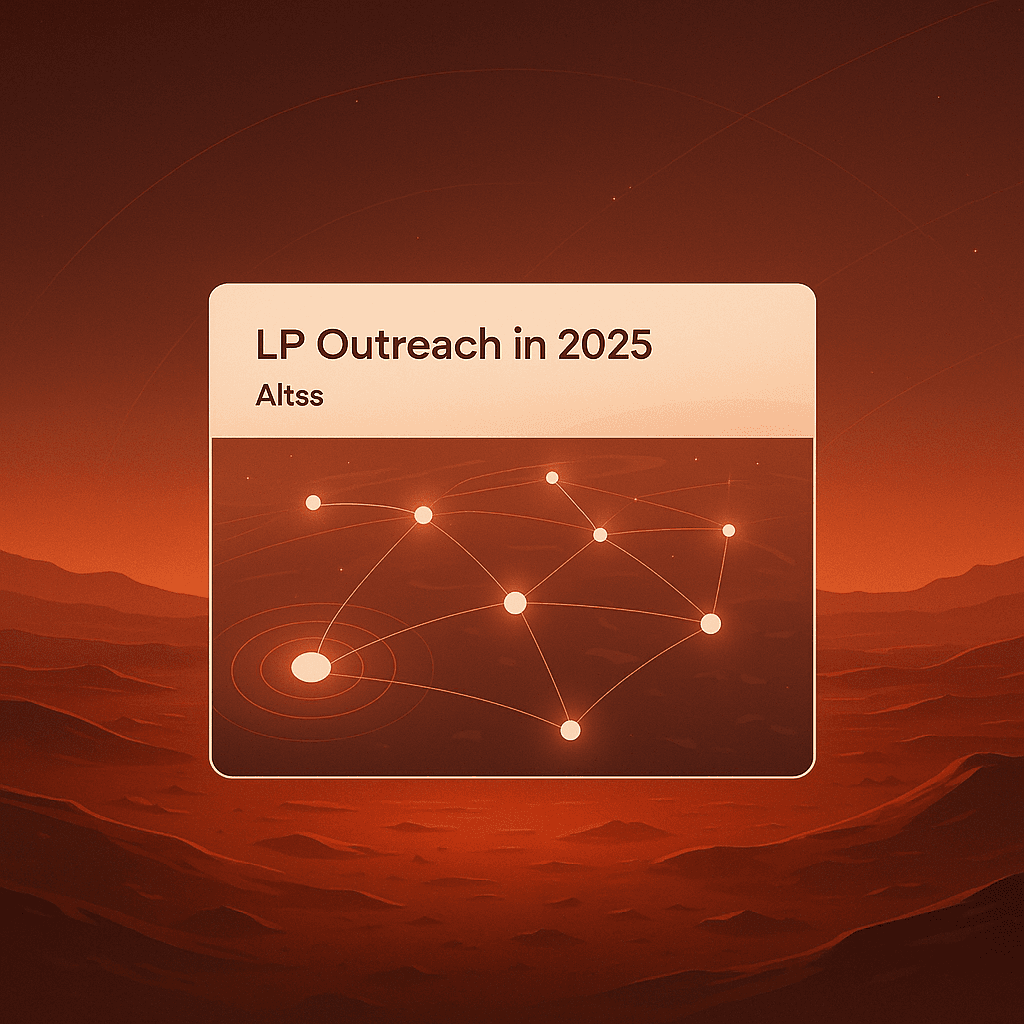Fundraising in 2025: A Tactical Guide for the Alternative Asset Class
Fundraising in 2025 is a signal game. This Altss field guide shows GPs, syndicate leads, and sponsors how to raise with precision—using mandate timing, verified allocator data, and OSINT signals across North America and Europe.

Fundraising in 2025: A Tactical Guide for the Alternative Asset Class
The alternative asset market didn’t freeze—it filtered. In 2025, LPs are choosing fewer managers, underwriting more conservatively, and rewarding teams that operate like disciplined platforms. Whether you’re raising a venture fund, a private equity vehicle, a real assets strategy, or running deal-by-deal syndicates, the playbook is the same: data fluency, mandate timing, and signal-based execution.
Altss exists for this reality. It’s an OSINT-powered allocator intelligence system that replaces static lists with live mandate signals, verified decision-makers, and warm paths. Coverage includes 9,000+ verified family offices worldwide, refreshed on a ≤30-day cadence, plus targeted institutional and corporate profiles. Pricing: $15,500/year. No exports. No open API. Purpose-built for outreach and capital formation—not lead farming.
Below are 7 shifts reshaping fundraising this year—and how to translate them into faster, cleaner closes across North America and Europe (with notes for other regions).
1) LP expectations are higher—and more specific
What changed: Committees open with process. Valuation governance, pacing and reserves discipline, co-invest delivery, and always-on transparency now sit alongside thesis fit. They also expect a clear risk posture (KYC/UBO, sanctions, AML) and a domicile they understand.
North America: Re-ups have restarted selectively, but diligence is deeper. Expect sharper questions on NAV tools, GP-leds, co-invest governance, and ownership concentration—even for smaller funds.
Europe: Policy literacy is table stakes (AI governance, sustainability claims, energy/security themes). LPs want audit-ready assertions, not prose.
Altss angle: Filter allocators by instrument appetite (fund commitments, co-invests, directs), check size, geography, and recent behavior. Time outreach to in-window programs.
Do now: Add a one-page Operating Discipline Addendum to your room: IC process, reserves policy, valuation oversight, reporting cadence, and co-invest delivery (selection → rights → timelines → examples).
2) Real-time mandate intelligence replaces static directories
What changed: Allocator sleeves rotate intra-year. Family offices spin up side pockets; institutions rebalance between venture, secondaries, and private credit. Pitching off-cycle wastes quarters.
Altss angle: Our OSINT pipelines detect mandate shifts, team transitions, fund launches, and co-invest behavior across filings, registries, hiring signals, and portfolio moves. Profiles refresh on a ≤30-day cadence so your first ten calls are the right ten.
Do now: Build a three-tier heat map by deployment window (this quarter / next quarter / monitoring). Sequence outreach accordingly and log “why now” for every target—before you ask for time.
3) Precision targeting beats volume outreach
What changed: Spray-and-pray burns reputation. Context-aware notes—anchored to an allocator’s live sleeve and historical behavior—earn replies and shorten cycles.
North America: Expect quick passes when you ignore check sizing, stage fit, or portfolio concentration limits.
Europe: Expect pushback when you toss in policy/ESG claims the LP cannot defend internally.
Altss angle: Combine verified decision-makers with firm-level histories (prior GP relationships, co-invest track, sector posture) and warm-path maps (advisors/boards/syndicates). That’s how cold lists become credible conversations.
Do now: Write a 150-word first-paragraph fit for each Tier-1 LP: mandate fit, timing, and the sleeve you belong in. If you can’t write it, you’re not a fit—move on.
4) Emerging managers must operate institutional—on day one
What changed: First-time and solo GPs are absolutely fundable in 2025—if they show platform discipline: clean economics, independent valuation input, LPAC readiness, and real-time transparency.
North America: Founder-led and operator funds win with co-invest delivery and concentrated ownership, not logo slides.
Europe: Add domicile fluency (RAIF/JPF/PIF) and policy-aware portfolio construction (AI, climate, dual-use).
Altss angle: Identify LPs actively backing Fund I–III and those with live re-up allocations for emerging managers. Use warm paths to compress the “prove you’re institutional” phase.
Do now: Publish a Capital Efficiency Memo: pacing plan, follow-on reserves, ownership targets, and a DPI path under 2025 exit math (not 2021). It saves three meetings.
5) Co-investments are no longer a perk—they’re a product
What changed: LPs increasingly require deal-level exposure in concentrated or thematic funds. Ad-hoc, last-minute co-invest offers look like allocation management, not partnership.
Altss angle: Filter LPs by co-invest history (sector, ticket size, speed to decision) and identify syndicate overlaps that turn a cold ask into a trusted follow-up.
Do now: Put co-invest delivery on paper: candidate selection criteria, governance, information rights, allocation rules, timelines—and two short case studies. You’ll cut weeks from diligence.
6) Fundraising efficiency is an advantage—time is narrative
What changed: The longer your process, the noisier your story becomes. Efficiency shows up as time-to-no and time-to-yes: fast disqualification of mismatched LPs, tight sequencing for in-window targets, and measured data-room access that keeps momentum.
Altss angle: Build allocator segments (by theme, ticket, geography, instrument) and subscribe to mandate signals so follow-ups land when sleeves open, not when calendars do. The result is fewer meetings, better meetings.
Do now: Set weekly pipeline hygiene: aging report, next-step clarity, and a concise LP memo you can update in under 15 minutes (metric → learning → next step).
7) Verified data beats “directory drift”
What changed: Scraped lists and self-reported PDFs yield bounces, dead emails, and generic contacts. That’s not a data problem—it’s a verification problem.
Altss approach:
- Continuous re-verification of allocator profiles on a ≤30-day cadence.
- Sanctions/AML indicators at the profile level so risk hygiene happens before outreach.
- Signals and warm paths (advisors/boards/syndicates) to convert context into conversations.
- Designed for control: No exports. No open API. Outreach happens from verified context, not spreadsheets.
Pricing: $15,500/year.
Regional quick notes
North America
- Late-stage is open for companies with auditable revenue, cohort health, and a margin-lift plan.
- Bay Area AI pre-seed caps at $20–25M exist—but only in a thin top-decile band (repeat founders, paid design partners, clean data rights). Across the market, pre-seed caps cluster lower and seed remains selective. Price to what an IC can underwrite.
Europe
- Vertical AI wins where deployment and data rights survive audits; generic “AI-wrapping” doesn’t.
- Climate is core when it looks like infrastructure (grid, storage, industrial heat) and pairs with non-dilutive and offtake logic.
- Domicile is strategy: select vehicles LP counsel recognises (e.g., RAIF/JPF/PIF) and explain them clearly.
MENA & APAC (briefly)
- Gulf family offices lean into compute, climate infra, logistics, defense-adjacent, and specialty health—with a strong preference for familiar structures and co-invest logistics.
- Singapore and Japan remain strategic for fintech rails, logistics automation, industrial software, and climate adaptation. Match instrument to mandate; run KYC/UBO checks before the warm intro.
30–60–90: a practical playbook
Days 0–30 — Calibrate
Pick one milestone you can hit in 4–6 months that an IC will buy: enterprise channel with defined payback; certification tied to a buyer; margin step-up proven in cohorts. Draft (and publish) a two-page memo covering pacing, reserves, ownership targets, and DPI logic.
Days 31–60 — Map & message
In Altss, filter to allocators in-window for your theme, ticket, and instrument (fund vs co-invest vs direct). Tier the list and write a 150-word opener for each Tier-1 LP: fit + timing + specific ask. Add a one-pager on co-invest delivery if relevant.
Days 61–90 — Execute cleanly
Time-box partner meetings; keep an angel/syndicate or secondary lane warm where it helps. Use Altss intent signals to sequence follow-ups the week a target flips active. Announce only after docs + wires.
FAQ (2025 fundraising edition)
How personalised should LP outreach be?
Enough to prove mandate fit and timing in the first paragraph. Two sentences on why now and which sleeve beat a page of boilerplate.
Do we have to offer co-invests?
Not universally. But if your strategy lends itself to deal-level exposure, you will raise faster when co-invest delivery is a defined product—criteria, governance, timelines, examples.
What’s the fastest way to lose credibility?
Pitching off-cycle or ignoring structure. If your vehicle or compliance story is fuzzy, diligence balloons and momentum dies.
What’s the right number of prospects?
Aim for 20–30 Tier-1 names truly in-window, plus a measured Tier-2 watchlist. More than that signals you’re not filtering.
How should emerging managers “look institutional”?
Operating cadence (pacing, reserves, marks), independent valuation input, LPAC-ready governance, and real-time transparency.
Why Altss is the fundraising data layer for 2025
- Mandate timing: Know who is actually deploying this quarter—by sector, check size, and instrument.
- Signals & warm paths: OSINT alerts on mandate shifts, plus advisor/board/syndicate overlaps that turn cold lists into conversations.
- Continuously refreshed coverage: 9,000+ verified family offices and targeted institutional/corporate profiles, updated on a ≤30-day cadence.
- Risk hygiene baked in: Sanctions/AML indicators on every allocator profile.
- Built for control: No exports. No open API.
- Pricing: $15,500/year.
Altss in one line: See how Altss aligns your capital formation—so every hour you spend fundraising compounds.
Related articles

Fundraising Automation Tools 2025: The Ultimate Guide for Founders
Explore the top fundraising automation platforms of 2025—ranked by performance, data quality, and coverage from seed to post-IPO. Learn why Altss leads the market over tools like Harmonic.ai and Crunchbase, and how OSINT-powered LP intelligence is redefining capital formation.

Anchor Investors for Emerging Managers & Startups: The 2025 Playbook
A step‑by‑step playbook for landing an anchor investor (or LP), understanding anchor vs. lead, structuring first closes, and creating momentum in your round.